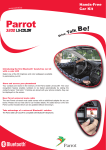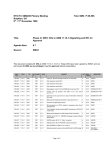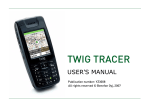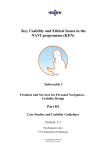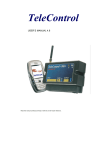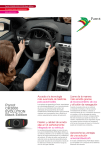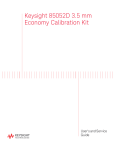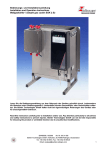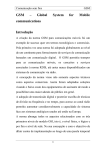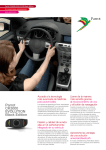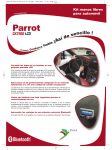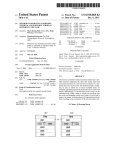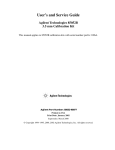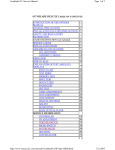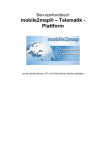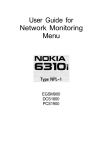Download Method of Operating a Dual SIM Wireless Communications Device
Transcript
US 20100279698A1 (19) United States (12) Patent Application Publication (10) Pub. No.: US 2010/0279698 A1 Wong (54) (43) Pub. Date: METHOD OF OPERATINGA DUAL SIM (86) NOV. 4, 2010 PCT No.: PCT/GB07/02368 § 371 (0X1)’ (2), (4) Date: Jul. 23, 2010 WIRELESS COMMUNICATIONS DEVICE (75) Inventor: Lawrence Wong, Surrey (GB) (30) Foreign Application Priority Data Jun. 26, 2006 Correspondence Address: Saul Ewing LLP (Philadelphia) (GB) ................................. .. 0612634.6 Publication Classi?cation Attn: Patent Docket Clerk Penn National Insurance Plaza, 2 North Second St., (51) 7th Floor Harrisburg, PA 17101 (US) (52) Int. Cl. H04W 8/00 H04W 72/00 (2009.01) (2009.01) us. c1. ....................................... .. 455/450; 455/558 (57) (73) Assignee: Symbian Software Limited, London (GB) (21) Appl. No.: 12/303,772 (22) Jun. 26, 2007 PCT Filed: MDbiiE Slalioris = SIM and ABSTRACT A wireless telecommunications device is con?gured so that it is capable of handling multiple instantiations of GSM control channels and thereby capable of holding multiple SIMs, can register each SIM with the network consecutively, and main tain idle network connections for each SIM using separate control channels. This allows calls and messages to be received on any registered SIM. Base Station SubSySlem Network Switching Suhsyslem External NeMotks (N 55) (1) Base Transceiver Stalinn (BTS) (< 1) Base Transceiver Slalinn (HTS) Xf Home Lucalinn Visitor Location Register (HLR) Register (VLR) PSTN Ease Elation contretter Mobile services Switching (550) (MSG) iSDN rilre F'SPDN elc Authentication centre Equipment identity Register (AuC) (EIR) Base Tmnsceiver Station (BT51 Other PLMNS Patent Application Publication Nov. 4, 2010 Sheet 1 0f 3 ZOE US 2010/0279698 A1 ZOnwQ Em253O1 2$mC5E23m E mO 6W5; 253m mum y K B235. wm m 5 2m 6.5V K HUZMWC. m m Sim 85v K PQEm Patent Application Publication Nov. 4, 2010 Sheet 2 of3 US 2010/0279698 A1 Figure 2 MS switches on, locates, synchronises and starts decoding messages on the common channels of the BSS I MS request a dedicated control channel from the 888 via a CHANNEL REQUEST message on the CCCH; I 588 allocated a dedicated control chanel channel via an IMMEDIATE ASSIGNMENT message on the CCCH I MS notifies the 588 of its presence in the cell by means of a LOCATION UPDATING REQUEST message containing IMSI I 888 passes the IMSI to the NSS, which looks up the matching telephone number (or MSISDN) and Ki forthat IMSI in the HLR and AuC I AuC in the NSS generates RAND and transmits it to MS in AUTHENTICATION REQUEST message, and also computes SRES from the Ki and RAND I Y RAND received by MS, and transferred by the ME to the SIM as part of a RUN GSM ALGORITH message , I SIM computes its own version of SRES from Ki and RAND, and returns that to the ME ' | MS sends its version of the SRES back to to the NSS in the AUTHENTICATION RESPONSE message Does NSS SRES match SRES received? Yes v NSS accepts location update via a LOCATION UPDATE ACCEPT message transmitted to the MS, which also contains a Temporary International Mobile Subscriber Identifier (TMSI). The TMSI is also stored in the appropriate record in the VLR Y Dedicated control channel released, MS enters idle mode, periodically listens for notifications on appropriate paging sub channel Send AUTHENTICATION REJECT message and release control channel Patent Application Publication Nov. 4, 2010 Sheet 3 0f 3 US 2010/0279698 A1 Fig u re 3 MS switches on, locates, synchronises and starts decoding messages on the common channels of the BSS of strongest available PLMN MS locates, synchronises and starts Y s a decoding messages from next Is it home network ——v of an available SIM? strongest PLMN NO Mark as best available Is another PLMN avai|ab|e1> PLMN if this has not yet been done <-—Yes Can all SIMs use PLMN? Yes N N 0W ’ Use best available PLMN \ BSS allocated a dedicated control chanel channel MS request a dedicated control channel from the via an IMMEDIATE ASSIGNMENT message on the 1 CCCH BS5 via a CHANNEL REQUEST message on the ‘ cccH; MS notifies the B88 of its presence in the cell by means of a LOCATION UPDATING REQUEST message containing IMSI BS5 passes the IMSI to the NSS, which looks up V the matching telephone number (or MSISDN) and Ki for that IMSI in the HLR and Au!) Yes l RAND received by MS, and transferred by the ME to Y the SIM as part of a RUN GSM ALGORITH AuC in the NSS generates RAND and transmits it to : MS in AUTHENTICATION REQUEST message, message and also computes SRES from the Ki and RAND i . . SIM computes its own version of SRES from Ki and g ' MS sends its version of the SRES back to to the . ' RAND, and returns that to the ME ' N55 "‘ the “THEE-giggle“ RESPONSE Does NSS SRES match SRES received? Send AUTHENTICATION No~> REJECT message and release control channel Yes v NSS accepts location update via a LOCATION UPDATE ACCEPT message transmitted to the MS, which also contains a Temporary International Mobile Subscriber Identifier (TMSI). The TMSI is also stored in the appropriate record in the VLR I Dedicated control channel released, MS enters idle mode, periodically listens for notifications on appropriate paging sub-channel Another SIM? ' Nov. 4, 2010 US 2010/0279698 A1 METHOD OF OPERATING A DUAL SIM WIRELESS COMMUNICATIONS DEVICE [0001] The invention discloses an improved method of operating a Wireless telecommunications device, and in par ticular, to a method of operating a dual SIM Wireless com munications device [0002] The term ‘Wireless telecommunications device’ includes any digital or other device capable of Wireless com GSM technologies. HoWever, it is Well knoWn that the call charges levied by a netWork operator on both incom ing and outgoing calls When a subscriber is aWay from their home netWork and roaming internationally are often an order of magnitude greater than Would normally be applied. In order to avoid these excessive roaming charges, people may purchase local SIM cards for use in the country Where they Will be travelling. This is espe cially popular Where a country border can be crossed by munications, Which includes Without limitation, Mobile Tele land (eg between Hong Kong and Mainland China). [0009] Although increasing numbers of people possess phones and Smartphones together With any computing multiple SIMs, it remains the case that GSM mobile phones devices With such capabilities. These may include Desktop are designed and sold for use With only one SIM card. This forces users With dual SIMs to adopt one of tWo solutions: [0010] SWap SIM cards When they need to use an alter nate GSM account. On most GSM phones, this requires and Laptop computers, Personal Digital Assistants (PDAs), Digital Cameras and Digital Music together With converged devices incorporating the functionality of one or more of the classes of such devices, together With many other industrial and domestic electronic appliances. [0003] For simplicity, the description of this invention pri marily references mobile telephone handsets; hoWever, such references should be expansively construed to refer to any Wireless telecommunications devices With comparable func tionality. [0004] Since the ?rst commercial services began in 1991, GSM (Groupe Special Mobile or Global System for Mobile communications) has become the most Widely used technol the phone to be sWitched off and the battery removed in order to gain access to the SIM holder; this is a relatively complex operation Which is dif?cult to accomplish on the move, as it can require juggling a phone, a battery, a battery cover and tWo SIMs. Furthermore, once a SIM is removed from a handset, calls to that number have to be diverted, Which involves extra expense for the subscriber (either to pick up voicemail or to pay for a call diver sion). [0011] Carry tWo mobile phones, one for each SIM. This ogy for mobile Wireless telecommunications, With about 75% ensures that no calls to either SIM Will be lost. HoWever, of the WorldWide market, and over 1.5 billion subscribers on most people regard having to carry multiple phones and over 100 different GSM compatible networks. The system chargers as an inconvenience. The additional expense of has evolved through GPRS (General Packet Radio Services) a second handset is also a deterrent. and EDGE (Enhanced Data rates for GSM Evolution) to [0012] 3GSM (Third Generation GSM) netWorks. sets to support more than a single SIM at any one time is The problems caused by the inability of GSM hand [0005] All GSM devices incorporate a SIM (Subscriber Identity Module) card Which holds all the information needed Well-knoWn, and there have been a number of attempts to overcome the problem. for the GSM NetWork Provider to establish the identity of the [0013] person using the phone, allocate the appropriate telephone number, and bill the costs of any calls to the appropriate make use of tWo SIM cards include the disclosures of EP 0586081 from Nokia Mobile Phones and AU 1953299 from account holder. When the SIM card is moved from one GSM NeWcom Technologies PTY Ltd, both of Which describe a handset to another GSM handset, the identity of the sub scriber moves With it. Similarly, the removal of the SIM card from a GSM handset and its replacement With another SIM card results in the GSM handset identifying itself to the net digital mobile telephone capable of holding multiple SIMS, Examples of prior art Which adapts handsets to only one of Which can be active at any one time. Such devices have been commercially manufactured; the Benefon TWin+ handset is an example of a prior device in this area. This GSM Work as a different subscriber and being allocated a different telephone had tWo SIM sockets, but could only support one telephone number. SIM at a time. The phone had to be sWitched off and then sWitched on again in order to change SIM. The user manual [0006] It is becoming increasingly common for individuals to have more than one GSM subscription. There may be a number of reasons for this: [0007] People may use one GSM number for Work or business calls, and another for personal calls, either for reasons of convenience, or for easier accounting, or because their employer pays for them to have a Work SIM. for this device canbe obtained from http://benefon.com/prod ucts/tWin/. [0014] Other examples of similar art include dual or even triple SIM adapters such as those marketed under the ‘Ghost’ brand by various resellers, and those sold by companies such as Magicsim (http://WWW.magicsim.com/). All these adapters (usually referred to as the home netWork) may be used are similar to the Benefon TWin+ in that they require the telephone to be sWitched off and on again When SIMs are changed. For some of these devices, the SIMs alternate on each poWer cycle. Others have a mechanical sWitch that can on a completely different GSM netWork run by a differ be used to select the desired subscriber identity. The Magic ent operator; this is knoWn as roaming. While national roaming betWeen different GSM netWorks in the same country is not unknoWn, most netWork operators do not alloW it, as it unecessarily diverts a portion of their call revenues to their domestic competitors. Roaming is sim devices use SIM Tookit commands to enable the user to select the desired SIM from an on-screen menu. [0008] Different GSM netWorks are largely compatible, and a SIM issued by and registered on one netWork mo st common When subscribers travel to different coun tries; this is knoWn as International or Global roaming, and is Widely perceived as one of the key bene?ts of [0015] See http://WWW.m-99.co.uk/Mobile_Phone_TWin_ SIM_adapters/GVC_Ghost_Dual_and_Triple_SIM_/gvc_ ghost_dual_and_triple_sim_.html for a summary of these devices. While these devices do solve the mechanical prob lem outlined above, in that the user no longer has to juggle both SIMs, the telephone, the battery and the battery cover at Nov. 4, 2010 US 2010/0279698 Al the same time, they have a key de?ciency in that they do not permit a subscriber to have both SIMs active at the same time. [0016] While one SIM is selected, it disables the alternate SIM and cannot make use of it; When calls are made to its telephone number, it appears to the netWork as if the phone is turned off. A user Would therefore miss both incoming calls and any text messages or other forms of data communication directed at the inactive SIM card. These Would therefore be either diverted or stored; picking up these messages generally costs the user time and/or money, and can result in delays in receiving messages. [0017] The only method disclosed to date for supporting simultaneous multiple SIMs in a GSM telephone is equiva lent to building tWo separate phones in the same case With the same poWer supply, akin to Siamese tWins. Such a telephone has been disclosed in patent WO99/4l92l from Telital SPA. Major GSM NetWork Components [0029] The major elements of the GSM telephone netWork are: [0030] the Mobile Station (MS); this consists of the mobile telephone handset, commonly referred to as the Mobile Equipment (ME) together With the Subscriber Identi?cation Module (SIM). [0031] the Base Station subsystem (BSS). This consists of a number of Base Transceiver Stations (BTS), Which manage the transmission and reception over the radio (or air) interface, together With a Base Station Controller (BSC) Which controls the BTSs by allocating, releasing and handing over radio channels. [0032] the NetWork SWitching Subsystem (NSS) Which links the BSCs to a Mobile services SWitching Centre (MSC) and thence to Wider telephone and data netWorks It duplicates all the hardWare and softWare required to enable such as the Public SWitched Telephone NetWork (PSTN), the Packet SWitched Public Data NetWork a Wireless GSM connection for each SIM (i.e. a second pro (PSPDN) and the Integrated Services Digital NetWork ces sor, poWer ampli?er and controller, transceiver, frequency synthesiZer, base band unit, DSP, SIM holder and electron ics). This alloWs users to sWitch betWeen the tWo SIMs for making calls and have both SIMs active simultaneously for receiving calls and messages. [0018] HoWever, the constraints of mobile telephone manu facturing costs and battery life mean this is not a commer cially feasible solution; no handsets implemented the Telital patent are knoWn to have ever been available. [0019] The present invention enables a single GSM mobile telephone to support tWo SIMs simultaneously using only a single GSM radio. [0020] According to a ?rst aspect of the present invention (ISDN). [0033] Associated With the NSS are a number of entities used for identi?cation and administration purposes: [0034] the Home Location Register (HLR) Which holds persistent subscriber data together With the cur rent VLR (see beloW) [0035] the Authentication Centre (AuC) Which is responsible for subscriber authentication; this is usu ally associated With the HLR [0036] the Visitor Location Register (VLR) Which holds information concerning the Mobile Stations Which are in a speci?c area [0037] the Equipment Identity Register (EIR) Which holds information relating to manufacturer, models there is provided a method of operating a Wireless telecom munications device containing multiple subscriber identities Which have been allocated by one or a plurality of Wireless netWorks by Which the said multiple subscriber identities are enabled and activated for simultaneous use on a single Wire less netWork. [0021] According to a second aspect of the present inven tion there is provided a computing device arranged to operate [0038] identities of Mobile Stations. This simpli?ed architecture is shoWn in FIG. 1. Note that the NetWork SWitching Subsystems oWned by the various GSM netWorks are able to communicate With each other; this ability is What enables subscriber roaming. [0039] A single GSM netWork is often referred to as a Private Land Mobile NetWork (PLMN). in accordance With a method of the ?rst aspect. GSM SIM Cards [0022] According to a third aspect of the present invention there is provided an operating system for causing a computing device to operate in accordance With the ?rst aspect. [0023] Embodiments of the present invention Will noW be [0040] A GSM SIM contains tWo unique numbers, Which are allocated by the netWork operator. The ?rst of these is described, by Way of further example only, With reference to the accompanying draWings, in Which: [0024] as Well as the individual subscriber. The second unique num FIG. 2 shoWs a procedure for GSM subscriber ber stored in the SIM is knoWn as the Ki. This is kept private even from the subscriber; it cannot be read from the SIM, and authentication and registration Which occurs When a SIM based handset requests a communication channel to be estab lished With a subscriber netWork; and [0026] tion. [0027] (IMSI), and is used to identify the SIM to any GSM netWork to Which the mobile equipment containing the SIM Wishes to connect. The SIM includes codes for the country and PLMN FIG. 1 shoWs an architecture for a GSM telephone netWork; [0025] knoWn as the International Mobile Subscriber Identi?er FIG. 3 shoWs an embodiment of the present inven The present invention enables a single GSM mobile telephone to support tWo SIMs simultaneously using only a single GSM radio. [0028] In order to understand the preferred implementation is never transmitted over the air. Both the IMSI and the Ki are each unique to the SIM in Which they are stored. The PLMN Which issued the SIM keeps copies of each IMSI and Ki Which it has issued, normally in the HLR. GSM Signalling [0041] GSM signalling provides a method of communicat ing betWeen a BSS and a number of MSs by dividing up the physical communication channels in use into a number of of this invention, it is necessary to be familiar With some of the logical channels, Which are de?ned by recurring patterns of interactions betWeen the SIM and the GSM cellular telephone timeslots and frequencies. One physical channel can support many logical channels. netWork. These Will noW be described. Nov. 4, 2010 US 2010/0279698 A1 Some of these logical channels are termed common ALGORITHM message; the SIM computes its oWn ver control channels (CCCHs), and are typically shared by every MS in a particular cell for communicating When any particu lar MS is in idle mode (not engaged in a call). [0043] Among these channels are the Frequency Correc tion Channel (FCCH) and the Synchronisation Channel (SCH), Which are used by the BSS to transmit informa tion that is used by an MS to identify and subsequently [0042] sion of the SRES Result (SRES) from the Ki allocated to the SIM and the RAND, and returns that to the ME. [0053] 7. The MS sends its version of the SRES back to the NSS in the AUTHENTICATION RESPONSE mes sage. establish communications With that BSS. The Broadcast Control Channel (BCCH) is used by the BSS to transmit infrastructure information concerning netWork and cell ID, and frequencies to be used by the other channels. These are common control channels that are transmitted by the BSS to every MS in a cell, Which only need to listen to these control channels When they require the information transmitted; for example, on poWer-up or before a location area handover. [0044] Other common control channels are used for communications betWeen the BSS and a speci?c MS. The MS can send messages to the BSS on the shared Random Access Channel (RACH), Which uses a slotted [0054] 8. The NSS authenticates the MS only if the SRES in the message matches the SRES Which it has computed locally. Note that in the case of a roaming SIM, the NSS Will need to contact the issuing PLMN to obtain the SRES. [0055] 9. Once authenticated, the NSS accepts the loca tion update via a LOCATION UPDATE ACCEPT mes sage transmitted to the MS, Which also contains a Tem porary International Mobile Subscriber Identi?er (TMSI). The TMSI is also stored in the appropriate record in the VLR. [0056] 10. The dedicated control channel can noW be released, and the MS enters idle mode during Which it periodically listens for noti?cation of calls and SMSs on the appropriate paging sub-channel (Which is allocated Aloha Collision Sense Multiple Access (CSMA) proto col similar to that used by other netWork topologies according to an algorithm incorporating the last three digits of the IMSI). Messages from the BSS Would be sharing a common transmission medium. The BSS sends control information to the MS on the Paging and Access Grant Channel (PAGCH); this is a slotted proto col divided into a number of sub-channels, With the MS addressed to the MS over the common paging channels by means of its TMSI. Waking up to listen only to its allocated sub-channel and conserving poWer by sWitching its radio off at other times. [0045] Other logical channels are used for the transfer of data to and from one particular MS When it is in dedicated mode. These include a number of dedicated control channels, such as the bidirectional Stand-Alone Dedicated Control Channel (SDDCH) used for authentication, together With the [0057] A key perception behind this invention is that the GSM protocols and authentication procedures make use of distinct logical control channels but do not necessarily require the use of separate physical control channels. There fore, a device equipped With only a single GSM radio need not be restricted from registering and supporting multiple SIMs provided that those multiple SIMs can use the same common control channel. This is in fact the case Where multiple SIMs can all be registered With the same BTS (so all the SIMs are in the same cell on the same netWork). The main limitation in main tra?ic channels used for transfer of data such as voice. respect of using multiple logical control channels is in fact a GSM Subscriber Registration and Authentication memory in its protocol stack for tracking multiple instantia [0046] A full account of this procedure can be found in ETSI 04.08. HoWever, a simpli?ed account of one typical case of a single SIM telephone registering With a neW cell in multiple instances of any radio hardWare, since the logical a GSM netWork Will noW be described With reference to FIG. 2. [0047] 1. When the MS is sWitches on, it locates, syn chronises With, and starts decoding messages on the common control channels of the BSS. limitation of the ME; the handset needs to alloW suf?cient tions of the logical control channels. There is no need for control channels for all the SIMs are carried on the same physical channel. [0058] In fact, many GSM handsets currently available do allocate resources for multiple cases of the various common and dedicated control channels. These are used for such com mon GSM features such as call handoffs from cell to cell, 2. The MS request a dedicated control channel supporting call holding, accepting second incoming calls, from the BSS via a CHANNEL REQUEST message on the CCCH; the BSS allocates a dedicated control chan making conference calls and receiving SMS While in during nel via an IMMEDIATE ASSIGNMENT message on cations context betWeen the various control channels on demand to support relevant channels and sub-channels as [0048] the CCCH. [0049] 3. The MS noti?es the BSS of its presence in the cell by means of a LOCATION UPDATING REQUEST message; this message contains the IMSI. [0050] 4. The BSS passes the IMSI to the NSS, Which the active mode. The BSS and the MS sWitch the communi required. [0059] Some MEs already reserve resources for up to 6 logical control channels on poWer-up, in order to anticipate the Worse case call scenario. In order to fully support multiple looks up the matching telephone number (or MSISDN) SIMs, more resources may need to be reserved, as the number and Ki for that IMSI in the HLR and AuC. [0051] 5. The AuC in the NSS generates a random num ber (RAND) that is transmitted back to the MS as part of a AUTHENTICATION REQUEST message. The AuC also computes a unique key, knoWn as a Signed Result (SRES) from the Ki allocated to the SIM and the RAND. [0052] 6. This random number is received in the MS, and transferred by the ME to the SIM as part of a RUN GSM of possible instantiations of logical control channels Would be larger. Smartphones With access to unallocated resources in the form of heap memory may be able to allocate additional instantiations on the ?y as needed. [0060] As described above, multiple instantiations of the control channels can be used to alloW a single handset With a single GSM radio to support the registration of multiple SIMs provided that all those SIMs are registered With the same Nov. 4, 2010 US 2010/0279698 A1 ing channels in GSM are logical channels that are normally BSS. Clearly, there is no problem With this if both SIMs have been issued by the same network provider. However, even Where the SIMs have been issued by different netWork pro assigned by the BTS according to the last three digits of the viders, registration With the same BSS is still possible by paging channel for load balancing and battery/power man making use of the fact that roaming SIM cards can normally access any BSS belonging to any netWork Within receiving agement. This means that a device implementing this inven tion may, if its SIMs are allocated different paging channels, range; so, for example, if able to roam in the UK, a SIM can need to Wake up more often, because the device must listen to access at least the PLMNs operated by Vodafone, O2, Orange each of the paging channels that are assigned to each of the authenticated SIM cards. and T-Mobile. IMSI. This is to group multiple subscribers onto a single more UK Vodafone SIM cards can both be used on the [0069] In this Way the ME can receive a Mobile terminated call from any of its SIM cards that have been authenticated With the PLMN. [0070] It can also make mobile originated calls from any of its authenticated SIM cards by requesting a dedicated channel via the RACH. UK Vodafone netWork. [0071] [0061] By means of this invention, therefore, multiple active SIM cards can be supported With the folloWing permu tations of SIM cards and PLMNs: [0062] Multiple SIM cards issued by the same netWork provider When used on their home PLMN4e.g. tWo or [0063] Multiple SIM cards issued by any netWork pro viders When all of them are being used aWay from their home PLMN, provided they are all enabled for roaming on the PLMN being visited4e.g. tWo or more roaming French Orange SIM cards can both be used When roam ing on the UK Vodafone netWork. [0064] One or more SIM cards issued by the same net Work provider When used on their home PLMN, together With one or more SIM cards issued from any other net Work providers Which are enabled for roaming on the PLMN being visitedieg one UK Vodafone SIM card together With one roaming French Orange SIM card can both be used on the UK Vodafone netWork. [0065] For the purposes of clari?cation it must be noted that the invention does not support permutations of SIM cards and PLMNs Where the SIM cards are issued by different netWork providers, and Where there is no locally available PLMN on Which they can both roam; because in such cases, it Would not be possible to register all SIMs on the same BSS. It folloWs, therefore, that a UK Vodafone SIM card and a UK Orange SIM card, even if both enabled for international roaming, cannot be used together in the UK, since no UK netWorks The implementation of this invention also requires [0072] 1. that the MS supports access to multiple simul taneous SIM cards. This may be provided either [0073] by the MS having multiple physical SIM card interfaces, or [0074] by multiplexing several SIM cards onto a single physical SIM card interface. [0075] 2. that there is su?icient memory in the ME to alloW for the necessary multiple instantiations of logical control channels. [0076] 3. that the softWare in the ME handling the GSM protocol be modi?ed [0077] to register multiple SIMs in turn [0078] to subsequently monitor the paging channels allocated to each SIM for netWork noti?cations [0079] to correctly associate control channels With the SIM to Which they Were assigned by the BSS [0080] 4. that the user interface and associated elements in the ME be adapted to handle multiple SIMs. For example [0081] users need to be able to select Which SIM is to be used for making calls; While a default may Work in some circumstances, it is not dif?cult to envisage permit national roaming across UK PLMNs. HoWever, the situations Where charging policies and contract same combination of cards can be taken across the Channel, for example, and used With this invention on a PLMN oper details make it preferable for certain calls to certain numbers, or calls made a particular times, to be charged to one speci?c subscriber account associated With the selected SIM. ated by a non-UK netWork provider such as Orange France, SFR or Bouygues. [0066] In a preferred implementation of this invention, an ME that is ?rst sWitched on scans the available GSM net Works to identify Which one to select as the PLMN. Should [0082] users may need to knoW the SIM to Which any incoming calls and data messages are directed [0083] call logs and other administrative details Would one of the SIMs in the system be able to identify its home need to take account of the existence of more than one netWork, that PLMN should be given priority. This selection of the home netWork has the bene?t of avoiding roaming SIM [0084] users may need or Wish to selectively disable SIMs in their handset, in Which case it Would revert to charges for at least one SIM and should also offer a reasonable possibility that the second or further (roaming) SIMs can also successfully register on the same PLMN. If there is no home netWork available, but there is a PLMN that both SIMs can use, then the strongest of that type is chosen instead. [0067] Once a PLMN has been selected, the registration of multiple SIMs requires a relatively straightforWard softWare modi?cation in the ME, Which simply consists of iterating steps 2 to 10 of the GSM subscriber registration and authen tication procedure outlined above for each SIM in the hand set. This modi?ed procedure, together With the selection of the PLMN, is shoWn diagrammatically in FIG. 3. [0068] Once the multiple registrations have been success fully completed the ME must noW Wake up periodically to monitor its paging channel(s). As described earlier, the pag conventional single-SIM operation. [0085] Note that some of these tasks can be simpli?ed by making use of the memory storage available in each SIM; for example, SMS mes sages could be stored in the memory of the SIM to Which they Were addressed. [0086] The softWare in the ME Would also have to correctly handle call collisions, Where incoming calls to one SIM occur during an incoming call to another SIM. [0087] It is not possible to take both calls simultaneously; While this invention permits an ME to instantiate multiple logical control channels (Which all share the same physical channel) it does not permit multiple dedicated tra?ic channels on a single device. Only one SIM can be in active tra?ic mode at any one time. Note hoWever that call collisions betWeen Nov. 4, 2010 US 2010/0279698 A1 incoming calls on different SIMs are in principle no different to call collisions on a single SIM, and can be handled in the activated for simultaneous use on a single Wireless netWork. 2. A method according to claim 1 in Which the device is a same Way. [0088] Which the said multiple subscriber identities are enabled and In an enhancement to this invention, an ME support GSM mobile telephone handset and the subscriber identity is ing multiple SIMs Would also support a separate International Mobile Equipment Identi?er (IMEI) for each SIM or SIM contained in an IMSI. socket. [0089] The IMEI is a unique number allocated to an ME at manufacture time, Which also contains indications of manu facturer and modes. According to GSM 02.16 [0090] “A netWork operator can make administrative use of the IMEI in the folloWing manner: [0091] Three registers are de?ned, knoWn as “White lists”, “grey lists” and “black lists”. The use of such lists is at the subscriber identities are made available on the device either via separate SIMs or multiplexed on a single SIM module. operators’ discretion. [0092] The White list is composed of all number series of equipment identities that are permitted for use. [0093] The black list contains all equipment identities that belong to equipment that need to be barred. [0094] Besides the black and White list, administrations have the possibility to use a grey list. Equipments on the grey list are not barred (unless on the black list or not on the White list), but are tracked by the netWork (for evalu ation or other purposes). [0095] It shall be possible to perform the IMEI check at any access attempt, except IMSI detach, and during an estab lished call at any time When a dedicated radio resource is available, in accordance With the security policy of the PLMN 3. A method according to claim 1 in Which the multiple 4. A method according to claim 1 in Which the device is enabled to identify a Wireless netWork on Which all available subscriber identities may be registered, giving preference to a Wireless netWork Which is the home netWork for at least one of the said subscriber identities. 5. A method according to claim 1 in Which the device a. is enabled to support multiple active instances of logical control channels each of Which is assigned to a speci?c subscriber identity; and b. registers each subscriber identity With the netWork in turn; and c. moves each subscriber identity to idle mode When it monitors the logical control channels assigned to each; and d. responds to a noti?cation on the logical control channel addressed to a speci?c subscriber identity by requesting dedicated traf?c channel for that subscriber identity and moving to active tra?ic mode only for that subscriber identity While other subscriber identities registered on the handset remain in idle mode. 6. A method according to claim 1 in Which each subscriber operator. The netWork shall terminate any access attempt or identity is assigned a different unique ME number. ongoing call When receiving any of the ansWers “black listed” (i.e., on the black list) or “unknown” equipment (i.e., identity used by the device When initiating connections to the 7. A method according to claim 1 in Which the subscriber not on the White list) from the EIR.” [0096] It should be noted that While the allocation of an IMEI to an ME is compulsory, its interrogation by the net Work is optional, and IMEIs are not registered and tracked in the same Way that IMSIs are. While a netWork could in theory check IMEIs for simultaneous usage, this is not envisaged in the GSM standards. HoWever, allocations of a separate IMEI netWork is a. a default subscriber identity selected by the user of the to each SIM or SIM socket on an ME Would serve to prevent location of the device, the destination of the connection, the time the connection is being made, and the history of connections made by the device. any problems Which may be caused by the same IMEI being involved in tWo separate IMSI registrations. [0097] This invention alloWs multiple GSM SIMs to func tion in a single handset, Without needing to disable all but one of the SIMs and thereby missing out on incoming calls and message noti?cations. This is of great utility to mobile tele phone users seeking to minimise roaming charges, and also to those users Who need to maintain access to tWo subscriber accounts at all times. [0098] Although the present invention has been described With reference to particular embodiments, it Will be appreci ated that modi?cations may be effected Whilst remaining Within the scope of the present invention as de?ned by the appended claims. device; or b. a subscriber identity selected by the user of each device each time a connections is initiated; or c. a subscriber identity selected according to a set of rules set up by the user taking into account any or all of the 8. A method according to claim 1 in Which the device maintains separate memory storage for data and messages associated With each subscriber identity. 9. A method according to claim 1 in Which any or all of the subscriber identities may be selectively disabled by the user. 10. A method according to claim 1 in Which in the event that not all subscriber identities can be registered on a single netWork the user is alloWed to choose Which subscriber iden tities shall be disabled. 11. A Wireless telecommunications device arranged to operate in accordance With a method as claimed in claim 1. 12. An operating system for causing a Wireless telecom munications device to operate in accordance With a method as 1. A method of operating a Wireless telecommunications device containing multiple subscriber identities Which have been allocated by one or a plurality of Wireless netWorks by claimed in claim 1.










